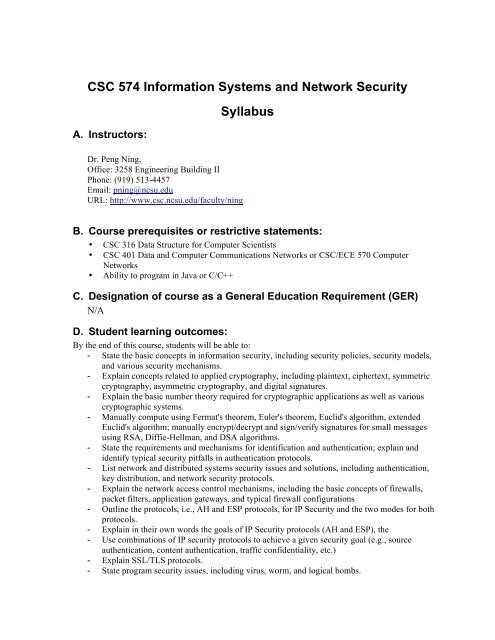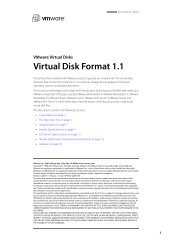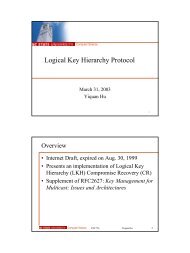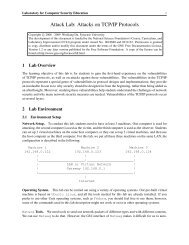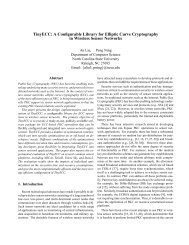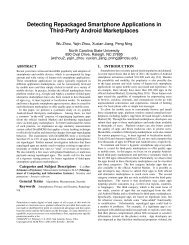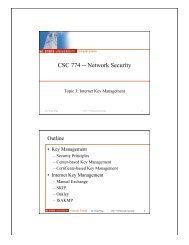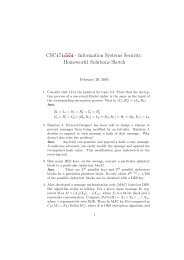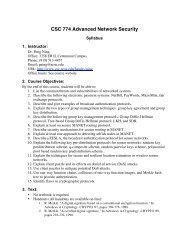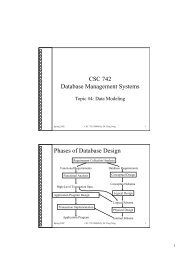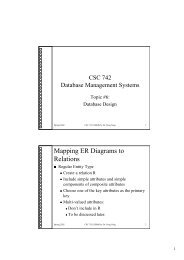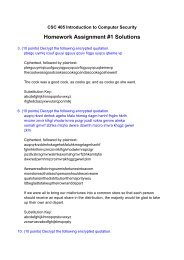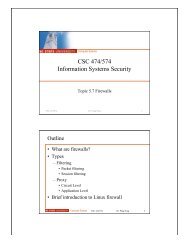CSC 574 Information Systems and Network Security ... - Dr. Peng Ning
CSC 574 Information Systems and Network Security ... - Dr. Peng Ning
CSC 574 Information Systems and Network Security ... - Dr. Peng Ning
Create successful ePaper yourself
Turn your PDF publications into a flip-book with our unique Google optimized e-Paper software.
<strong>CSC</strong> <strong>574</strong> <strong>Information</strong> <strong>Systems</strong> <strong>and</strong> <strong>Network</strong> <strong>Security</strong><br />
A. Instructors:<br />
Syllabus<br />
<strong>Dr</strong>. <strong>Peng</strong> <strong>Ning</strong>,<br />
Office: 3258 Engineering Building II<br />
Phone: (919) 513-4457<br />
Email: pning@ncsu.edu<br />
URL: http://www.csc.ncsu.edu/faculty/ning<br />
B. Course prerequisites or restrictive statements:<br />
• <strong>CSC</strong> 316 Data Structure for Computer Scientists<br />
• <strong>CSC</strong> 401 Data <strong>and</strong> Computer Communications <strong>Network</strong>s or <strong>CSC</strong>/ECE 570 Computer<br />
<strong>Network</strong>s<br />
• Ability to program in Java or C/C++<br />
C. Designation of course as a General Education Requirement (GER)<br />
N/A<br />
D. Student learning outcomes:<br />
By the end of this course, students will be able to:<br />
- State the basic concepts in information security, including security policies, security models,<br />
<strong>and</strong> various security mechanisms.<br />
- Explain concepts related to applied cryptography, including plaintext, ciphertext, symmetric<br />
cryptography, asymmetric cryptography, <strong>and</strong> digital signatures.<br />
- Explain the basic number theory required for cryptographic applications as well as various<br />
cryptographic systems.<br />
- Manually compute using Fermat's theorem, Euler's theorem, Euclid's algorithm, extended<br />
Euclid's algorithm; manually encrypt/decrypt <strong>and</strong> sign/verify signatures for small messages<br />
using RSA, Diffie-Hellman, <strong>and</strong> DSA algorithms.<br />
- State the requirements <strong>and</strong> mechanisms for identification <strong>and</strong> authentication; explain <strong>and</strong><br />
identify typical security pitfalls in authentication protocols.<br />
- List network <strong>and</strong> distributed systems security issues <strong>and</strong> solutions, including authentication,<br />
key distribution, <strong>and</strong> network security protocols.<br />
- Explain the network access control mechanisms, including the basic concepts of firewalls,<br />
packet filters, application gateways, <strong>and</strong> typical firewall configurations<br />
- Outline the protocols, i.e., AH <strong>and</strong> ESP protocols, for IP <strong>Security</strong> <strong>and</strong> the two modes for both<br />
protocols.<br />
- Explain in their own words the goals of IP <strong>Security</strong> protocols (AH <strong>and</strong> ESP), the<br />
- Use combinations of IP security protocols to achieve a given security goal (e.g., source<br />
authentication, content authentication, traffic confidentiality, etc.)<br />
- Explain SSL/TLS protocols.<br />
- State program security issues, including virus, worm, <strong>and</strong> logical bombs.
- State the basic concepts <strong>and</strong> general techniques in security auditing <strong>and</strong> intrusion detection.<br />
- Explain <strong>and</strong> compare the various access control policies <strong>and</strong> models as well as the assurance<br />
of these models.<br />
- State the characteristics of typical security architectures, including multi-level security<br />
systems.<br />
- State the criteria of evaluating secure information systems, including evaluation of secure<br />
operating systems <strong>and</strong> secure network systems.<br />
E. Textbooks:<br />
• Charlie Kaufman, Radia Perlman, <strong>and</strong> Mike Speciner, <strong>Network</strong> <strong>Security</strong>: Private Communication<br />
in a Public World, 2nd Edition, Prentice Hall, 2002, ISBN: 0-13-046019-2. (Price: USD 54.99)<br />
• H<strong>and</strong>outs<br />
H1. S<strong>and</strong>hu, R.S. Lattice-based access control models, IEEE Computer, 26(11): 9 –19, Nov.<br />
1993.<br />
H2. S<strong>and</strong>hu, R.S.; Coyne, E.J.; Feinstein, H.L.; Youman, C.E. Role-based access control<br />
models, IEEE Computer, 29(2): 38 –47, Feb. 1996.<br />
H3. <strong>Peng</strong> <strong>Ning</strong>, Sushil Jajodia, “Intrusion Detection Techniques,” In H. Bidgoli (Ed.), The<br />
Internet Encyclopedia. John Wiley & Sons. ISBN: 0-471-22201-1. December 2003.<br />
F. Course Organization <strong>and</strong> Scope:<br />
(Assume each lecture takes 75 minutes. These will be adjusted based on the actual<br />
progress in a semester.)<br />
T1. Basic <strong>Security</strong> Concepts (1 lecture)<br />
o Confidentiality, integrity, availability<br />
o <strong>Security</strong> policies, security mechanisms, assurance<br />
T2. Basic Cryptography (1 lecture)<br />
o Historical background<br />
o Transposition/Substitution, Caesar Cipher<br />
o Introduction to Symmetric crypto primitives, Asymmetric crypto primitives, <strong>and</strong><br />
Hash functions<br />
T3. Secret Key Cryptography (3 lectures)<br />
o Data Encryption St<strong>and</strong>ard (DES)<br />
o Advanced Encryption St<strong>and</strong>ard (AES)<br />
o Encrypting large messages (ECB, CBC, OFB, CFB, CTR)<br />
o Multiple Encryption DES (EDE)<br />
T4. Message Digests (2 lectures)<br />
o Applications<br />
o Strong <strong>and</strong> weak collision resistance<br />
o The Birthday Paradox<br />
o MD5, SHA-1<br />
T5. Public Key Cryptography (4 lectures)<br />
o Number theory: Euclidean algorithm, Euler Theorem, Fermat Theorem, Totent<br />
functions, multiplicative <strong>and</strong> additive inverse<br />
o RSA, Selection of public <strong>and</strong> private keys<br />
T6. Authentication (4 lectures)<br />
o Basic concepts of identification <strong>and</strong> authentication<br />
o Password authentication<br />
o Authentication protocols<br />
T7. Trusted Intermediaries (2 lecture)
o Public Key infrastructures<br />
o Certification authorities <strong>and</strong> key distribution centers<br />
o Kerberos<br />
T8. Real-time Communication <strong>Security</strong> (5 lectures)<br />
o IPsec: AH <strong>and</strong> ESP<br />
o IPsec: IKE<br />
o SSL/TLS<br />
o Firewall<br />
o Auditing <strong>and</strong> intrusion detection<br />
T9. Access Control (2 lectures)<br />
o Basic concepts of access control<br />
o Discretionary access control <strong>and</strong> m<strong>and</strong>atory access control<br />
o Lattice-based Models<br />
o Covert Channels<br />
o Role based Access Control<br />
T10. Miscellaneous topics (1 lecture)<br />
o Assurance <strong>and</strong> Evaluation of Secure <strong>Information</strong> <strong>Systems</strong><br />
o Database <strong>Security</strong> (<strong>Security</strong> requirements in databases, Access control <strong>and</strong><br />
authorization in databases, Inference control)<br />
o Malicious software<br />
o Administrating <strong>Security</strong> (Risk Analysis, <strong>Security</strong> Planning, Organizational<br />
<strong>Security</strong> Policies)<br />
G. Schedule of reading assignments:<br />
• Topic T1: Chapter 1.<br />
• Topic T2: Chapters 2 – 7.<br />
• Topic T3: Chapters 9 – 12.<br />
• Topic T4: Chapters 13 – 19, 23; H<strong>and</strong>out H3.<br />
• Topic T5: H<strong>and</strong>outs H1 – H2.<br />
• Topic T6: TBD.<br />
H. Projected schedule of homework due dates, quizzes <strong>and</strong> exams:<br />
There are 5 homework assignments <strong>and</strong> 2 exams. Quizzes are given in the form of pop quizzes. Pop<br />
quizzes are adopted to encourage the students to study during the non-exam weeks. The results of pop<br />
quizzes are not counted in the final grade.<br />
• Homework 1: topics T1 <strong>and</strong> T2, due by week 3<br />
• Homework 2: topics T2 <strong>and</strong> T3, due by week 6<br />
• Homework 3: topic T4, due by week 9<br />
• Homework 4: topic T5, due by week 11<br />
• Homework 5: topics T5 <strong>and</strong> T6, due by week 13<br />
• Mid-term exam: week 8<br />
• Research project report: due by week 15<br />
• Final exam: decided by the university.<br />
I. Grading:<br />
• Assignments 15%, projects 10%, class participation 5%, midterm 35%, final 35%.<br />
• The final grades are computed according to the following rules:<br />
o A+: >= 95%<br />
o A: >= 90% <strong>and</strong> < 95%
o A-: >= 85% <strong>and</strong> < 90%<br />
o B+: >= 80% <strong>and</strong> < 85%<br />
o B: >= 75% <strong>and</strong> < 80%<br />
o B-: >= 70% <strong>and</strong> < 75%<br />
o C+: >= 66% <strong>and</strong> < 70%<br />
o C: >= 63% <strong>and</strong> < 66%<br />
o C-: >= 60% <strong>and</strong> < 63%<br />
o D+: >= 56% <strong>and</strong> < 60%<br />
o D: >= 53% <strong>and</strong> < 56%<br />
o D-: >= 50% <strong>and</strong> < 53%<br />
o F: < 50%.<br />
J. Policies on incomplete grade <strong>and</strong> late assignments:<br />
Homework <strong>and</strong> project deadlines will be hard. Late homework will be accepted with a 10% reduction<br />
in grade for each class period they are late by. However, once a homework assignment is discussed in<br />
class or the solution is posted, submissions will no longer be accepted. All assignments must be<br />
turned in before the start of class on the due date.<br />
K. Policies on absences (excused <strong>and</strong> unexcused) <strong>and</strong> scheduling<br />
makeup work:<br />
The university policy on absences will be enforced. See the university policy at the following URL.<br />
http://www.ncsu.edu/provost/academic_regulations/attend/reg.htm<br />
• The students are responsible for discussing makeup exams if they miss exams due to excused<br />
absence. The instructor will choose a mutually agreed date <strong>and</strong> time for the makeup exam.<br />
• Late submission of homework assignments due to excused absences is not subject to the policies<br />
on late assignments.<br />
L. Academic integrity:<br />
The university, college, <strong>and</strong> department policies against academic dishonesty will be strictly enforced.<br />
You may obtain copies of the NCSU Code of Student Conduct from the Office of Student Conduct,<br />
or from the following URL.<br />
http://www.ncsu.edu/policies/student_services/student_discipline/POL11.35.1.php.<br />
The instructor expects honesty in the completion of test <strong>and</strong> assignments. It is the underst<strong>and</strong>ing <strong>and</strong><br />
expectation of instructor that the student's signature on any test or assignment means that the student<br />
neither gave nor received unauthorized aid.<br />
M. NC State policy on working with students with disabilities:<br />
“Reasonable accommodations will be made for students with verifiable disabilities. In order to take<br />
advantage of available accommodations, students must register with Disability Service for Students at<br />
1900 Student Health Center, Campus Box 7509, 515-7653.<br />
http://www.ncsu.edu/provost/offices/affirm_action/dss/<br />
For more information on NC State’s policy on working with students with disabilities, please see<br />
http://www.ncsu.edu/provost/hat/current/appendix/appen_k.html.
N. Laboratory Safety or Risk Assumption: Not Applicable.<br />
O. “Pass-through” Charges: Not applicable.<br />
P. Statement on transportation: Students have to provide their<br />
transportation for all class related trips.


